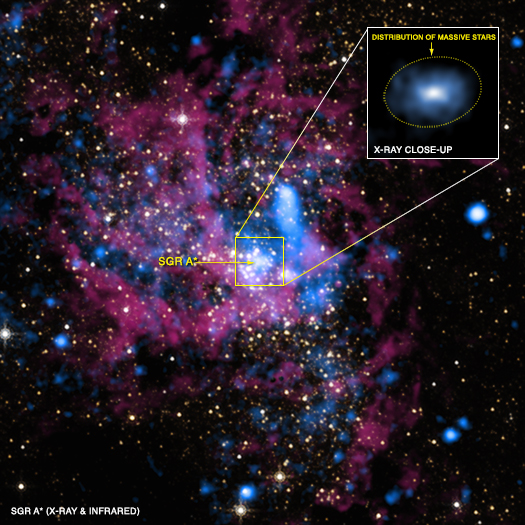NASA | Marshall | SAO | Chandra X-ray Observatory | 2013 Aug 29
The center of the Milky Way galaxy, with the supermassive black hole Sagittarius A* (Sgr A*) located in the middle, is revealed in these images. As described in our press release, astronomers have used NASA's Chandra X-ray Observatory to take a major step in understanding why gas around Sgr A* is extraordinarily faint in X-rays.
The large image contains X-rays from Chandra in blue and infrared emission from the Hubble Space Telescope in red and yellow. The inset shows a close-up view of Sgr A* only in X-rays, covering a region half a light year wide. The diffuse X-ray emission is from hot gas captured by the black hole and being pulled inwards. This hot gas originates from winds produced by a disk-shaped distribution of young massive stars observed in infrared observations (mouse over the image for the distribution of these massive stars).
These new findings are the result of one of the biggest observing campaigns ever performed by Chandra. During 2012, Chandra collected about five weeks worth of observations to capture unprecedented X-ray images and energy signatures of multi-million degree gas swirling around Sgr A*, a black hole with about 4 million times the mass of the Sun. At just 26,000 light years from Earth, Sgr A* is one of very few black holes in the Universe where we can actually witness the flow of matter nearby.
The authors infer that less than 1% of the material initially within the black hole's gravitational influence reaches the event horizon, or point of no return, because much of it is ejected. Consequently, the X-ray emission from material near Sgr A* is remarkably faint, like that of most of the giant black holes in galaxies in the nearby Universe.
The captured material needs to lose heat and angular momentum before being able to plunge into the black hole. The ejection of matter allows this loss to occur.
This work should impact efforts using radio telescopes to observe and understand the "shadow" cast by the event horizon of Sgr A* against the background of surrounding, glowing matter. It will also be useful for understanding the impact that orbiting stars and gas clouds might make with the matter flowing towards and away from the black hole.
Credit: X-ray (NASA/CXC/Q.D.Wang (UMass) et al.); IR (NASA/STScI)
Dissecting X-ray-emitting Gas around the Center of our Galaxy - Q. D. Wang et al
- Science 341(6149) 981 (30 Aug 2013 DOI 10.1126/science.1240755
arXiv.org > astro-ph > arXiv:1307.5845 > 22 Jul 2013
Why Supermassive Black Holes Consume Less Material than Expected
University of Massachusetts, Amherst | 2013 Aug 29
Our Galaxy’s Supermassive Black Hole is a Sloppy Eater
Universe Today | Jason Major | 2013 Aug 29


